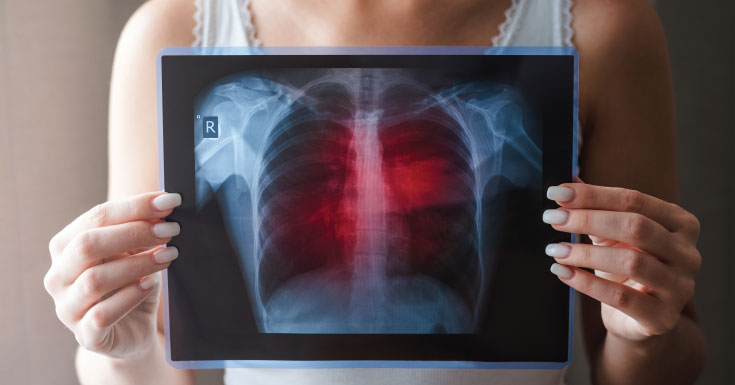Lung cancer is a devastating disease that affects the lives of many people throughout the world. Approximately 2.2 million new cases of lung cancer are diagnosed yearly worldwide. A staggering figure of 1.8 million lung cancer deaths are reported every year. It is the second most common cancer worldwide and it is the number one cause of cancer related mortality worldwide.
In Malaysia, lung cancer is the third most common cancer. It is the most common cancer among males and the fourth most common among females. In 2020, in Malaysia alone there were an estimated cancer deaths due to lung cancer of 4,509.
What is Lung Cancer?
Lung cancer arises from the uncontrolled growth of abnormal cells within the lungs which can be limited to the lung or can spread to other organs of our body. Broadly lung cancer can be divided into non-small cell lung cancer (NSCLC) and small cell lung cancer (SCLC). Almost 80-85% of lung cancers are due to NSCLC whereas the balance 15-20% is made up of SCLC. The common types of NSLCCs are adenocarcinoma (most common form), squamous cell carcinoma and large cell carcinoma. SCLC is a more aggressive form of lung cancer which tends to spread easily to other parts of the body (metastasise).
Risk factors for Lung Cancer
There are modifiable and non-modifiable risk factors for developing lung cancer. Cigarette smoking is the main risk factor for lung cancer. This includes exposure to second hand smoking or passive smoking. Other known risk factors are exposure to asbestosis which can be found in construction materials such as roof and ceiling tiles. The next is exposure to radon and other chemicals such as arsenic and nickel which can also increase your risk of developing lung cancer.
Non-modifiable risk factors include a family history of lung cancer. An individual who has a first degree relative (parent or sibling) with lung cancer stands a higher chance of developing lung cancer. Another risk factor is a history of chronic lung diseases such as chronic bronchitis, lung fibrosis and pulmonary tuberculosis which can also be a risk factor.
Clinical Presentation of Lung Cancer
Symptoms of lung cancer tend to present when the patient is at an advanced stage of the disease. This is a contributing factor which can worsen the prognosis and 5-year survival in lung cancer. Common symptoms of lung cancer are:
- Chronic non-resolving cough
- Difficulty breathing
- Unexplained chest pain
- Unexplained loss of weight
- Loss of appetite
- Generalised lethargy
- Coughing out blood
Having these symptoms does not confirm the presence of lung cancer but warrants an investigation to find out the underlying cause. Therefore, to improve the outcome of lung cancer, it is suggested that lung cancer be screened in individuals who are at high risk, who are asymptomatic.
Screening for Lung Cancer
It is recommended for individuals who have no symptoms but are at high risk including
- Those aged 50 to 80 years and in fairly good health
AND - Current smokers or have quit in the past 15 years
AND - Have at least a 20 pack-year smoking history. (This is the number of packs of cigarettes per day multiplied by the number of years smoked.)
A low-dose computed tomography scan (LDCT) is the best available test for lung cancer screening. The scan only takes a few minutes and is not painful. You do not need to fast before the scan and do not need any prior blood test or IV medication.
The pathway to Lung Cancer diagnosis
If you present with any suspected signs and symptoms of lung cancer, your doctor would probably run some tests to determine the origin of your symptoms. Among others, you would probably have to undergo a simple Chest X-ray. If anything suspicious is found (e.g. growth or nodules), you may be subjected to further tests.
Next, you might have to have a computed tomography (CT) scan which will be able to reveal smaller tumours not detected on a simple chest X-ray. A CT scan also can detect the size, shape and position of the lung tumour. It also helps in determining whether the cancer has spread to other organs.
The next step would be obtaining a small amount of tissue from the suspected lung tumour or from nearby lymph nodes the sample can be obtained via various modalities but the two commonest modalities would be a bronchoscopic biopsy or CT-guided biopsy. The specimen would be sent for histological analysis by a pathologist to determine the nature of cancer. Once it has been confirmed to be a cancer the specimen may be subjected to immunohistochemical testing (if there is a need to confirm the origin of the cancer) and also molecular testing (to determine the best option of treatment). Some patients may have to undergo further tests such as a PET scan to determine their suitability for surgery.
What Stage of Lung Cancer do I have?
This is a common question asked by the patient upon being diagnosed with lung cancer. Once the diagnosis has been established, the next step is to determine the extent (stage) of the cancer, such as the size of the tumour and if it is contained within one lung or involves both lungs. Other than that, it also has to be determined whether the cancer has spread to other organs (outside the lungs- metastatic disease). By staging the cancer the doctor is able understand the patient’s chances of survival and plan the appropriate modality of treatment. In Malaysia, almost 95% of lung cancer cases are detected at an advanced stage (III and IV) in both men and women.
Treatment Modalities available for Lung Cancer
There have been a lot of advancements in the treatment of lung cancer in the last decade. However, there is no denying the fact that the earlier the cancer is detected, the better is the outcome for the patient. The modality of treatment chosen will depend on the type of lung cancer and the stage at which it is diagnosed. Other aspects taken into consideration would be the genetic mutations present in the cancer (from the molecular analysis), the patient’s age and general health status. Last but not least, is the patient’s concerns and wishes. Surgery would be the treatment of choice in the early stage of lung cancer and produces a good outcome. Some cases require surgery to be combined with other forms of treatment such as chemotherapy. If the patient is not a candidate for surgery, then options such as chemotherapy, radiotherapy or chemotherapy combined with radiotherapy can be offered. Therefore one must understand that treatment is very personalised and can vary from one individual to another. Newer forms of treatment have also improved the quality of life for patients undergoing treatment such as targeted therapy and immunotherapy which are now available for patients who have been diagnosed with lung cancer.
Therefore the journey from diagnosis to treatment of lung cancer can be a long one, but with the right approach the outcome can be optimised.

Consultant Respiratory, Internal Medicine and Sleep Medicine,
Pantai Hospital Ayer Keroh
















